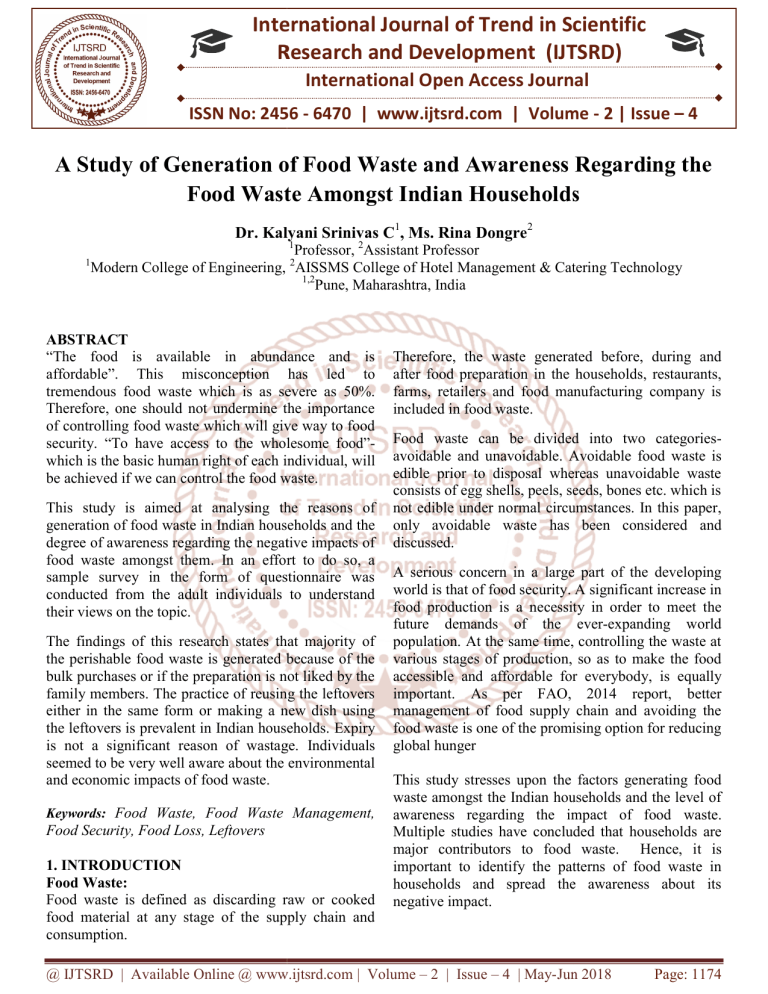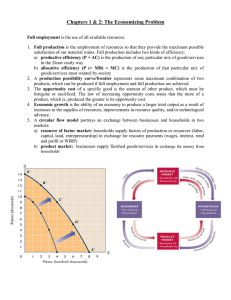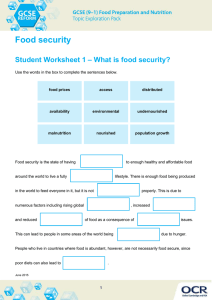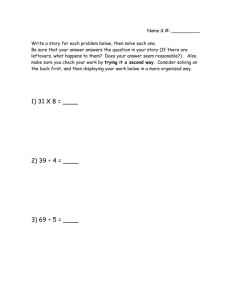
International Journal of Trend in Scientific
Research and Development (IJTSRD)
International Open Access Journal
ISSN No: 2456 - 6470 | www.ijtsrd.com | Volume - 2 | Issue – 4
A Study of Generation of Food Waste and Awareness Regarding the
Food Waste Amongst Indian Households
Dr. Kalyani Srinivas C1, Ms. Rina Dongre2
1
1
Professor, 2Assistant Professor
Modern College of Engineering,, AISSMS College of Hotel Management & Catering Technology
1,2
Pune, Maharashtra, India
2
ABSTRACT
“The
The food is available in abundance and is
affordable”.
”. This misconception has led to
tremendous food waste which is as severe as 50%.
Therefore, one should not undermine the importance
of controlling food waste which will give way to food
security. “To have access to the wholesome food”which is the basic human right of each individual, will
be achieved if we can control the food waste.
This study is aimed at analysing the reasons of
generation of food
od waste in Indian households and the
degree of awareness regarding the negative impacts of
food waste amongst them. In an effort to do so, a
sample survey in the form of questionnaire was
conducted from the adult individuals to understand
their views on the topic.
The findings of this research states that majority of
the perishable food waste is generated because of the
bulk purchases or if the preparation is not liked by the
family members. The practice of reusing the leftovers
either in the same form or making a new dish using
the leftovers is prevalent in Indian households. Expiry
is not a significant reason of wastage. Individuals
seemed to be very well aware about the environmental
and economic impacts of food waste.
Keywords: Food Waste, Food Waste Management,
Food Security, Food Loss, Leftovers
1. INTRODUCTION
Food Waste:
Food waste is defined as discarding raw or cooked
food material at any stage of the supply chain and
consumption.
Therefore, the waste generated before, during and
after food preparation in the households, restaurants,
farms, retailers and food manufacturing company is
included in food waste.
Food waste can be divided into two categoriescategories
avoidable and unavoidable. Avoidable food waste
wa
is
edible prior to disposal whereas unavoidable waste
consists of egg shells, peels, seeds, bones etc. which is
not edible under normal circumstances. In this paper,
paper
only avoidable waste hass been considered and
discussed.
A serious concern in a large part of the developing
world is that of food security.. A significant increase in
food production is a necessity in order to meet the
future demands of the ever-expanding world
population. At the same time, controlling the waste at
various stages of production,
tion, so as to make the food
accessible and affordable for everybody,
everybody is equally
important. As per FAO, 2014 report, better
management of food supply chain and avoiding the
food waste is one of the promising option for reducing
global hunger
This study stresses
resses upon the factors generating food
waste amongst the Indian households and the level of
awareness regarding the impact of food waste.
Multiple studies have concluded that households are
major contributors to food waste. Hence, it is
important to identify the patterns of food waste in
households and spread the awareness about its
negative impact.
@ IJTSRD | Available Online @ www.ijtsrd.com | Volume – 2 | Issue – 4 | May-Jun
Jun 2018
Page: 1174
International Journal of Trend in Scientific Research and Development (IJTSRD) ISSN: 2456-6470
This study is an attempt to find out the consumption
patterns and thereby wastage patterns amongst the
Indian households.
2. LITERATURE REVIEW
1. Federica Marra (2013) in her study has claimed
that food losses and waste has got worldwide
attention in recent years because of its direct role
in threatening environmental, social and economic
sustainability. The study points to the generic
decrease in food availability due to sub-par
functioning of food systems and food value
chains. She further stated that because of
globalization, the food wasted in one part of the
world affects the availability and prices elsewhere,
thus making the consequences of food waste and
losses global.
2.
Rutten.M et al (2013), in the report, have
categorized the occurrence of food wastage in 5
categories- a) Agriculture, hunting and forestry, b)
Manufacturing, c) Wholesale & retail, d)
Foodservice and catering, and e) households. It’s
been mentioned there that maximum food wastage
occurs in households i.e. 30.9%
3. Monier et.al (2012), in his study has mentioned
that in EU, out of total food wastage, 42 % is
contributed by households, 39 % by the
manufacturing industry and 19 % by other sectors.
4. Lundqvist et.al (2008) in the study has identified
food waste as a cause of global concern that
affects the society, the environment as well as the
economy adversely. In Europe, approximately one
third, of the food produced for human
consumption is wasted every year. He has listed increase in population, changing dietary
preferences, urbanization, global warming as
some of the reasons for increase in global food
waste.
5. Beaver M in his study has claimed that 60 % of
the household waste in UK comprises of the food
which is not used in time. Perishable products are
the major contributors towards the food waste. He
claims that behaviors and attitude of customers
regarding the packaging is the major barrier to
reduce the food waste. Customers are ill-educated
regarding the benefits of existing packaging and
they don’t read and understand the instructions
carefully.
6. Lazaros & Shackelford (2008) have mentioned in
their study that household contributes to around
70% of the total food wastes internationally. The
residents purchase the food and do not consume.
Edible food is many times thrown in the dustbin.
They pointed that volume of the food waste
increases with the rise in disposable income.
7. Wolfgang et.al (2014) in his study has pointed out
that in the households generate waste based on
preferences for a certain level of quality of food
items. Some parts of food items are discarded
purely out of preference, for e.g. peeling of
potatoes, fish heads/tails, chicken skin, etc. Food
items are stored for a certain duration and then
simply thrown away without utilizing. Such type
of food wastage can be avoided by changing the
preferences to some extent.
Waste also depends upon the storage times at
household level: some food may not be considered
palatable after a while and is disposed. This can be
avoided by increasing shopping frequency so as to
reduce storage duration. Food waste might also be
avoided by spending more time on food
preparation, e.g. to peel fruits and vegetables more
carefully, or to prepare dishes from not completely
fresh products (e.g. to use stale vegetable
preparation for making stuffed paratha (Indian
bread), using stale roti( Indian Bread) to make
khakra (dried Indian bread eaten as snacks).
8. HKIED (2011) has claimed in its study that
Consumerism promotes the excessive purchasing
of food products without the consideration of
negative environmental impacts. He says that
consumerist lifestyle, which manifests in buying
excessive food stuff which ultimately is disposed.
It created significant environmental problems to
Hong Kong.
9. Macy .J, (2002) in her study pointed out that
unsuccessful food waste source reduction is
because of indifferent attitude regarding the
environment. Customers buys excessive food ,
don’t plan for the purchase, to avail bulk purchase
discounts ,often buy more than required, storing
equipment not functioning properly, improper
storage of food ,improper serving sizes, and
leftovers not being used are some of the
@ IJTSRD | Available Online @ www.ijtsrd.com | Volume – 2 | Issue – 4 | May-Jun 2018
Page: 1175
International Journal of Trend in Scientific Research and Development (IJTSRD) ISSN: 2456-6470
indifferent attitudes which contributes towards
wastage.
10. Yang, et al (2011) has claimed in the study that
since the facilities for proper recycling are not
available, it promotes the food waste generation in
households. Proper sorting of garbage in
households and socially responsible behavior is
required for waste reduction.
11. WRAP (2008) claims that, in the United Kingdom
(UK), one third of food products purchased by
household ends up in the waste bin. Of the total
wasted food, a staggering 61% or about 70 kg per
household can actually be avoided. 40% isn’t even
touched and at least 10% is wasted while within
its expiry period. About 45% of the food thrown
away in the UK by weight consists of salad items.
The main identified reasons for throwing away
edible food by WRAP are plate leftovers,
expiration date passed, aesthetic appearance,
moldiness and cooking leftovers. Lack of
awareness, oversized portions and consumer
attitude are some of the other reasons mentioned
for food wastage.
3. OBJECTIVES OF THE STUDY
1. To study out the reasons for food waste in
Indian Households.
2. To find out the amount of food wasted in
Indian households.
3. To analyze the level of awareness amongst the
Indian households regarding the impacts of
food waste.
of data collection. The feasts or festival days are the
special occasions where lot of other factors are
responsible for food waste, which can be a scope for
further research.
Methods of Data Collection
Primary data: It was collected with the help of
questionnaire technique. A structured questionnaire
was prepared and the responses are collected through
Social communication networks, further it was
tabulated using Google docs software
Secondary data: It was collected from published
literature on food waste management, latest references
available from the journals, newspapers, research
publications and magazines, and other relevant
sources like internet.
6. DISCUSSIONS, FINDINGS &
CONCLUSIONS
6.1 Discussions
6.1.1 Reasons for non-consumption of food
As per the findings, the major reason for the
non-consumption of the food in the houses is
overcooking followed by last minute outing
and changes in the meal plans. Another major
reason is the taste not liked by the family
members
6.1.2
Amount of food wasted:
A majority that is 79.8% has claimed that they
waste less than 5% of the food in their houses.
18.5% have agreed that they waste the food
between 5-10% in their houses while 1.7% of
the respondent has agreed that they waste
between 10-20% of the food. None of the
respondents have reported a wastage
exceeding 20%.
6.1.3
Impacts of food waste:
A majority that is 83.1% of the respondents
are aware that food waste has social, economic
as well as environmental impacts.
6.1.4
Awareness about the food waste:
Creating awareness amongst the general
public regarding the direct and indirect
repercussions of food waste on the economy,
environment and the society is one of the most
important tool to reduce the food waste.
Greater the awareness, more innovative
method would be adopted by the public to
4. LIMITATIONS OF THE STUDY
1. The study is based on responses received by
those
who
have
access
to
smart
phones/internet. A total of 123 responses were
received.
2. This study is conducted in current scenario.
The perceptions, opinions and behavior of the
respondents might change with time.
5. RESEARCH METHODOLOGY
Type of Research
This study is based on food waste generated in
households during day today life and does not include
feasts or festival days and included following methods
@ IJTSRD | Available Online @ www.ijtsrd.com | Volume – 2 | Issue – 4 | May-Jun 2018
Page: 1176
International Journal of Trend in Scientific Research and Development (IJTSRD) ISSN: 2456-6470
reduce the food waste. Majority of the
respondents strongly agree that controlling
food waste has nothing to do with the
affordability and 79.8% of the respondents
claim that the amount of the food wastage is
not more than 5% at their homes. 83.1% of the
respondents are aware that food waste has
social, economic and environmental impacts.
A miniscule 0.8% of the respondents disagree
with the notion of avoiding food waste even if
one can afford to.
6.2 Findings
@ IJTSRD | Available Online @ www.ijtsrd.com | Volume – 2 | Issue – 4 | May-Jun 2018
Page: 1177
International Journal of Trend in Scientific Research and Development (IJTSRD) ISSN: 2456-6470
6.3 Conclusions
In Indian culture, food is considered to be sacred.
Being a developing nation, the amount of food wasted
in India is comparatively less as compared to other
developed countries. However, the rise in disposable
income and easy accessibility to the food is gradually
giving rise to food waste in India. Excess quantity of
food cooked is the major reason for the food wastage.
Overall, the householders claim to be aware about the
repercussions of food waste and strongly agree that
food should not be wasted.
7. SUGGESTIONS & RECOMMENDATIONS
Based on the responses received following
suggestions can be made:
Cooking as per the requirements
Reusing the leftovers.
Better house hold planning which means
checking the stock at home before shopping.
8. BIBILIOGRAPHY
1) Federicca Marra, Fighting Food Loss and Food
Waste in Japan. (2013)
2) Rutten, M.M., Nowicki, P. L., Bogaardt, M.J. and
Aramyan L. H. (2013) ‘Reducing food waste by
households and in retail in the EU; A prioritization
using economic, land use and food security
impacts’, LEI Report 2013-035, The Hague: LEI,
part of Wageningen UR
3) Monier, V., Shailendra, M., Escalon V.,
O’Connor, C. Gibon, T. Anderson, G. Hortense,
M. Reisinger, H. 2010. Preparatory study on Food
Waste across EU27. European Commission (DG
ENV) Directorate C- Industry. 2010. Final Report.
ISBN: 978-92-79-22138-5. Evans, D. (2012).
‘Beyond the throwaway society: ordinary
domestic practice and a sociological approach to
household food waste sociology, 46(2012)
4) Lundqvist, J., De Fraiture, C. & Molden, D.
(2008) Saving Water: From Field to ForkCurbing Losses and Wastage in the Food Chain.
SIWI policy Brief. Stockholm: SIWI
5) Matthew Beaver- Managing Food Wastage in the
Consumer Household
6) Lazaros, Edward J, & Shackelford, Ray. (2008).
Don’t Throw It Away! Raise Recycling
Awareness Through Communications Project.
Tech Directions, 67(6), 19-23
7) Wolfgang, B., Hasan, D., Ferrari, E. (2014)
Economy-wide Impacts of food waste reduction:
A general Equilibrium Approach. Wolfgang Britz,
Hasan Dadu, Emanuele Ferrari
8) HKIED, & CSD. (2011). Sustainable development
in Hong Kong: Concepts, contexts and challenges
by Hong Kong institute of Education and Council
for sustainable Development.
9) Macy, Jack. (2002). Food residuals put city on
track to over 50 percent diversion. Biocycle,
43(2), 40-46
10) Yang, Lei, Li, Zhen-Shan, & Fu, Hui-Zhen.
(2011). Model of Municipal Solid Waste Source
Separation Activity: A case Study of Beijing.
Journal of the Air & Waste Management
Association, 61(2), 157-163
11) WRAP (2008): Research into Consumer Behavior
in Relation to Food Dates & Portion Sizes. Report
prepared by WRAP, Barbury
@ IJTSRD | Available Online @ www.ijtsrd.com | Volume – 2 | Issue – 4 | May-Jun 2018
Page: 1178





